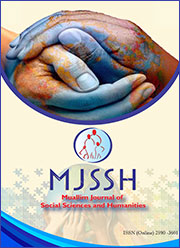Budi in direct confrontations portrayed in the Malaysian animation film Boboiboy: the movie (2016)
Keywords:
Budi, Malaysian animation, moral values, sympathyAbstract
BoBoiBoy: The Movie (2016) screening in local cinemas has successfully attracted local reception partly due to its portrayal of Malaysian culture and moral values, which local audiences find relatable. Despite the film presenting a modern and futuristic world, values based on Budi's traditional Malay concept are demonstrated throughout the main protagonist’s actions. This paper employs the concept of Budi from the academic study of Lim Kim Hui and includes my attempt to argue that Budi is represented in direct confrontations portrayed by the main protagonist as a form of the deliverance of justice towards the evildoers. Additionally, I adopt Smith’s “Structure of Sympathy” to discuss the spectator’s engagement with the protagonist, which influences the spectator to agree with the actions taken. The concept of Budi suggests that traditional values are not lost in modern times, but it progresses and evolves to suit contemporary practices. Boboiboy: The Movie is one of the digital mediums that exhibits Budi as a traditional moral concept that can be sustained and disseminated particularly to younger generations, which comprises the majority of the audiences.
References
Hassan Muthalib. (2016). From Mousedeer to Mouse: 70 Years of Malaysian Animation. Kuala Lumpur: ASWARA.
Lim, K. (2003). Budi as the Malay Mind: A philosophical study of Malay ways of reasoning and emotion in peribahasa. Hamburg: University of Hamburg.
Smith, M. (1995). Engaging characters: Fiction, emotion and cinema. Oxford: Clarendon Press.
Ismail Hamid. (1991). Masyarakat dan budaya Melayu [Malay society and culture]. Kuala Lumpur: Dewan Bahasa dan Pustaka.
Nor Hashimah Jalaluddin. (2015). Peribahasa ‘parasit’ dan akal Budi Melayu: Analisis semantik inkuisitif [The 'parasite' proverb and Malay akal Budi: An inquisitive semantic analysis.]. Seminar Antarabangsa Bangsa dan Sastera (pp. 281-293). Bangi: Universiti Kebangsaan Malaysia.
Winstedt, R. O. (1982). The Malay magician being shaman, saiva and sufi. Kuala Lumpur: Oxford University Press.
Abdul Malik. (2015). Kehalusan Budi dalam Karya Raja Ali Haji [The subtlety of Budi in the literary works of Raja Ali Haji]. Tanjung Malim: Universiti Pendidikan Sultan Idris.
Aminudin Mansor. (2008). Konsep 'Akal Budi' dalam Sastera Melayu [the concept of 'Akal Budi' in Malay literature]. Jurnal ASWARA, 3(2), 3-43.
Hashim Musa. (2008). Traditional Malay poems: Reflections of courteous disposition, gracious speech and supreme wisdom of the Malay psyche. Malay Literature, 21(1), 35-57.
Hashim Musa, Normahdiah Sheik Said, Rozita Che Rodi, & Siti Sarah Ab Karim. (2012). Hati Budi Melayu: Kajian keperibadian sosial Melayu ke arah penjanaan Melayu gemilang [Hati Budi Malay: A study of Malay social personality towards the generation of a glorious Malay]. GEMA Online™ Journal of Language Studies, 12(1), 163-181.
Hassan Ahmad. (2003). Metafora Melayu: Bagaimana pemikir Melayu mencipta makna dan membentuk epistemologinya [Malay Metaphor: How Malay thinkers create meaning and shape their epistemology]. Akademi Kajian Ketamadunan.
Julaina Nopiah, Nor Hashimah Jalaluddin, & Junaina Kasdan. (2017). Elemen dualisme dalam peribahasa: Pendekatan semantik inkuisitif [Elements of dualism in proverbs: An inquisitive semantic approach]. Melayu: Jurnal Antarabangsa Dunia Melayu, 10(1), 67-89.
Lim, K. (2010). How Malay proverbs encode and evaluate emotion? A paremiological analysis. Sari - International Journal of the Malay World and Civilisation, 28(1), 57-81.
Nur Afiqah Wan Mansor, & Nor Hashimah Jalaluddin. (2015). Deria rasa dalam kiasan Melayu: Analisis semantik inkuisitif [Sense of taste in Malay metaphors: An inquisitive semantic analysis]. Pelestarian dan Perekayasaan Bahasa (pp. 1-11). Kuala Lumpur: Dewan Bahasa dan Pustaka.
Suriati Zakaria, & Nor Hashimah Jalaluddin. (2016). Konsep ruang dalam Anggun Cik Tunggal: Analisis semantik inkuisitif [The concept of space in Anggun Cik Tunggal: An inquisitive semantic analysis]. Journal of Language Studies, 16(3), 187-204.
Romlah Ramli. (2013). Cultural appropriate communication in Malaysia: Budi Bahasa as warranty component in Malaysian discourse. Journal of Multicultural Discourses, 8(1), 65-71. doi:10.1080/17447143.2012.753895
Tham, S. (1970). Tradition, values and society among the Malays. Review of Southeast Asian Studies, 4, 40-50.
Kamus Dewan Edisi Keempat. (2018, January 10). Retrieved from Pusat Rujukan Persuratan Melayu: http://prpmv1.dbp.gov.my/Search.aspx?k=bermain+budi
Giraldo, D. T. (2019). Empathy and sympathy: Two contemporary models of character engagement. (N. Carroll, L. T. Di Summa, & S. Loht, Eds.) Cham, Switzerland: Springer Nature.
Pötzsch, H. (2013). Ubiquitous absence: Character engagement in the contemporary war film. Nordicom Review, 34(1), 125-144.
Ioannidou, J. (2012). The dark defender: Dexter and making heroes out of serial killers. 10th Global Conference Monsters and the Monstrous. Oxford.
Klift, A. v. (2014). Rooting for the morally questionable protagonist. Amsterdam: University of Amsterdam.
Bendazzi, G. (2016). Animation: A World History: Volume 2: The Birth of Style - The Three Markets. Florida: Taylor & Francis Group.
Lent, J. A. (2004). The "sleeper" status of Southeast Asian animation. Jurnal Komunikasi, 20, 183-199.
Dahlan Bin Abdul Ghani. (2015). Upin & Ipin: Promoting Malaysian culture values through animation. Historia y Comunicación Social, 20(1), 241-258.
Mohd Amin Mat Omar. (2015). Characteristics, audience reception and challenges in Malaysian animation. Kuala Lumpur: University of Malaya.
Nur Salawati Mohd Nadzria, & Hanita Hassan. (2013). The language identities of Malaysians as portrayed in Upin and Ipin. Jurnal Teknologi (Social Sciences), 65(2), 109–114.
Faryna Mohd Khalis, Normah Mustaffa, & Mohd Nor Shahizan Ali. (2016). The sense of local identity characteristic in Malaysian animation. International Journal of Arts & Sciences, 9(3), 485-496.
Mohd Suhaimi Juhan, & Norlela Ismail. (2019). Character design towards narrative believability of Boboiboy in the Malaysian animated feature film Boboiboy: The Movie (2016). 2nd International Conference on Advanced Research in Economics, Social Sciences & Trade Development. Retrieved from https://www.researchgate.net/publication/335026448
Perpustakaan Negara Malaysia. (n.d.). Retrieved from https://www.pnm.gov.my/manuskrip/melayu/03koleksi/302_hikayat.htm
Dore, R. A. (2022). The effect of character similarity on children’s learning from fictional stories: The roles of race and gender. Journal of Experimental Child Psychology, 214. doi:https://doi.org/10.1016/j.jecp.2021.105310
Published
 Abstract Display: 138
Abstract Display: 138  PDF Downloads: 167
PDF Downloads: 167 













 This work is licensed under a
This work is licensed under a